| Columns Retired Columns & Blogs |
I like to see products like this, where the manufacturer isn't cutting corners in an attempt to broaden their market. There are a few people who have more money than interior space, and this is a good solution.
For a welcome change from my usual routine, I drove 250 miles north, into snowy upstate New York, to measure Wilson Audio's Duette Series 2 in situ chez Dudley. I used DRA Labs' MLSSA system and a calibrated DPA 4006 microphone to measure the Wilson's frequency response in the farfield, and an Earthworks QTC-40 for the nearfield and spatially averaged room responses. The amplifier used for the quasi-anechoic responses was the solid-state Musical Fidelity 250W monoblock that I bought 10 years ago to use for all my speaker measurements. For the in-room response measurement, I used the amplifier Art used for his listening, tubed Shindo Corton-Charlemagne monoblocks.
The Duette's voltage sensitivity is specified as 92dB/W/m at 1kHz; my estimate was 91.6dB(B)/2.83V/m, which is both within experimental error of the specification and well above average. The Duette will play loudly with low-powered amplifiers. The specified nominal impedance is 4 ohms, with a minimum magnitude of 4.35 ohms at 160Hz. My measurement of the Duette's impedance is shown in fig.1. The magnitude (solid trace) remains between 4.3 and 6 ohms for almost the entire audioband above the bass, with a rise to 7 ohms in the upper midrange. The minimum magnitude is 4.24 ohms at 178Hz, and while the electrical phase angle briefly reaches high values between 20 and 80Hz, the effect of this will be ameliorated by the fact that the magnitude is high at the same frequencies.
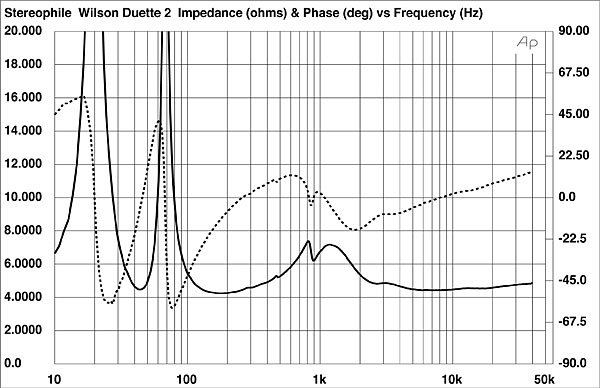
There are two small discontinuities in the impedance traces, one just below 500Hz and another, smaller one at 300Hz. This behavior in the midrange usually hints at some kind of vibrational behavior in a speaker's enclosure, and indeed, when I investigated the Duette's cabinet with a simple, plastic-tape accelerometer, I found a fairly strong resonance at 469Hz on both sidewalls and the top. To my surprise, however, this mode was strongest on the stand's pillar (fig.2). In general, the higher in frequency a resonant mode in an enclosure, the less likely it will be to color the sound, and at 469Hz, this measured resonance may well look worse than it sounds. I note that AD didn't comment on any midrange congestion that might have been laid at the feet of this mode.
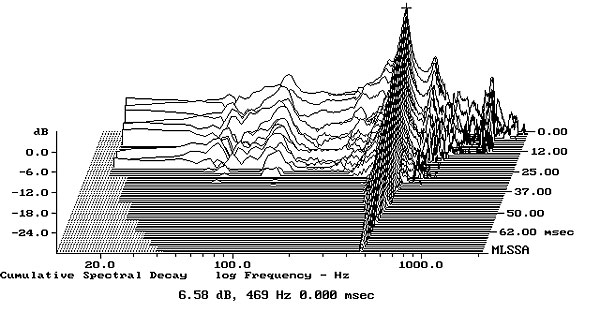
The accelerometer found no vibrational problems at 300Hz, the frequency of the other wrinkle in the impedance traces. However, when I looked at the nearfield output of the 3"-diameter port (fig.3, blue trace), I saw a well-suppressed mode at that frequency that disturbs what would otherwise be a well-controlled rollout. The saddle centered on 46Hz in the impedance-magnitude trace suggests that this is the tuning frequency of the port, and the woofer's nearfield response does indeed have a sharply defined notch at 46Hz (fig.3, red trace). The woofer cone is being held stationary at that frequency by the back pressure from the resonance, hence the notch. The woofer's output rises slightly through the midrange before crossing over to the tweeter (green trace) between 2 and 3kHz and rolling off with a fairly steep slope, this broken by small peaks at 2.8 and 5.1kHz. The tweeter's output is even within its passband, and the tweeter is still putting out energy on axis at the 30kHz limit of this graph.
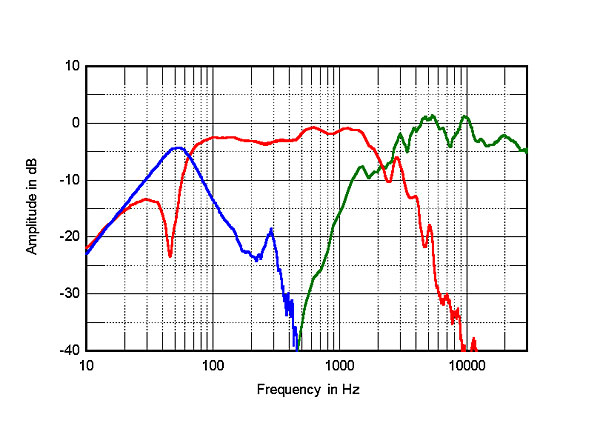
The overall farfield output, averaged across a 30° horizontal window centered on the tweeter axis and taken with the grille removed, is shown as the trace above 300Hz in fig.4. This trace is spliced at 300Hz to the complex sum of the nearfield woofer and port responses (taking into account acoustic phase and the different distances of the woofer and port from a nominal farfield microphone position). The small peak in the upper bass is an artifact of the nearfield measurement technique and is not as well developed as I usually find in two-way designs—the Duette's woofer alignment is optimized for the intended near-wall placement. Higher in frequency, the Duette's balance is relatively even, with small peaks balanced by small dips.
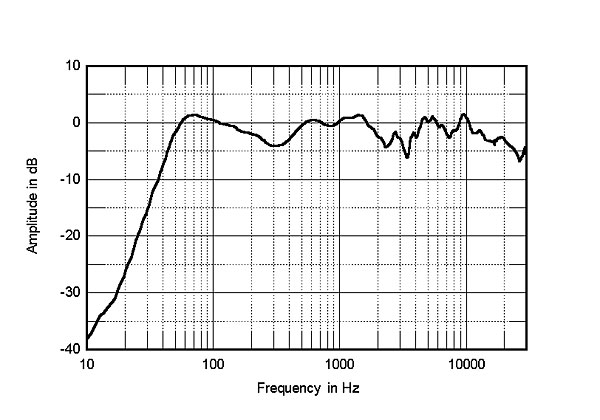
The plot of the Duette's lateral dispersion, referenced to the tweeter-axis response (which therefore is presented as a straight horizontal line), is shown in fig.5. By comparing this graph with fig.4, you can see that the small suckout between 3 and 5kHz in the on-axis frequency response (indicated by the cursor position in fig.5) fills in to the speaker's sides. This will give a neutral treble balance in all but very large rooms, where the Duette might sound a touch on the polite side. In the top octaves in this graph, the soft-dome tweeter's output drops off rapidly to the sides above 10kHz, which might lead to a slight lack of "air" to its balance in a well-damped room. In the vertical plane (fig.6), a significant suckout develops in the crossover region 5° and more above the tweeter axis. But as the speaker's integral stand places its tweeter some 38" above the floor, and we've found that 36" is the height of a typical seated listener's ears, this won't be a problem.
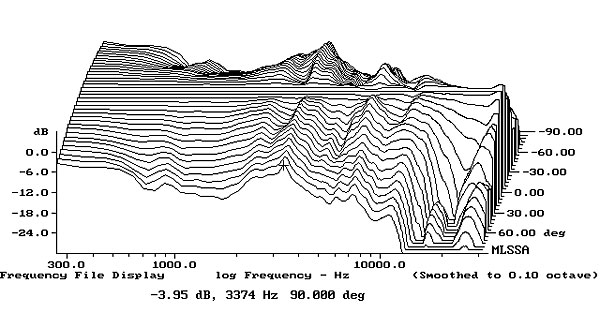
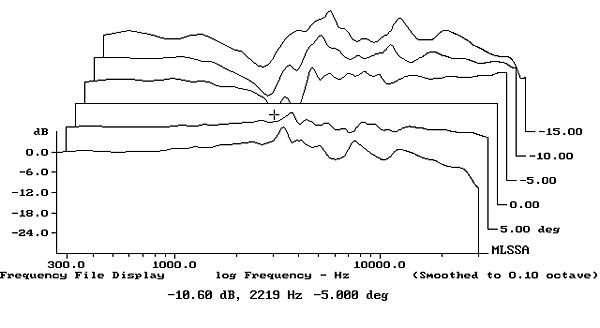
As I was visiting Art Dudley, I could measure the Duettes' in-room response. As usual, I averaged 20 responses taken in a rectangular grid 36" wide by 18" high and centered on a position 36" from the floor at AD's listening position (AD actually sits a little higher), which was 136" from the speakers. The results are shown as the red trace in fig.7. (The blue trace is the in-room response of the DeVore Fidelity Orangutan O/96s, measured in the same room in 2012.) As with other speakers that have been placed close to the corners of AD's room, there is a lack of energy between 150 and 300Hz that I suspect is due to destructive interference between the direct sound from the woofer and the reflections from the walls and floor. The two speakers produce curves that are very similar, with a smooth rolloff above the mid-treble, though the Duettes evidently produce more treble energy than the O/96s. The DeVore speakers were placed farther out in the room than the Wilsons, which means that the formers' low frequencies were better balanced. By contrast, there is a large peak between 50 and 80Hz in the Duettes' in-room response.

In the time domain, the Duette's step response on the tweeter axis (fig.8) is very similar to that of the Wilson Alexia, which I reviewed in December 2013. It reveals that while the tweeter is connected with positive acoustic polarity and the woofer in negative polarity, the decay of the tweeter's step smoothly blends with the start of the woofer's step, indicating an optimal crossover design that takes into account the slight backward slope of the front baffle. Some small ripples in the decay of the woofer's step are associated with some delayed mid-treble energy in the Duette's cumulative spectral-decay plot (fig.9).
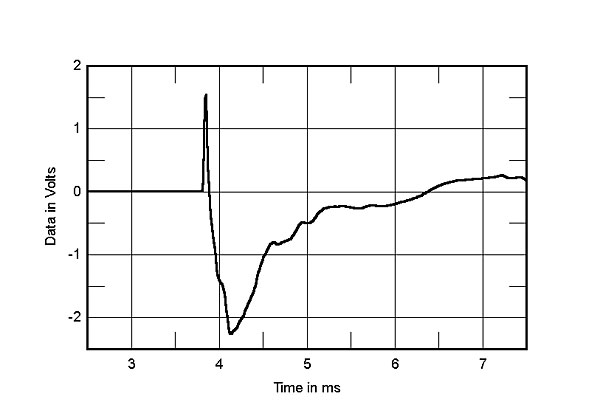
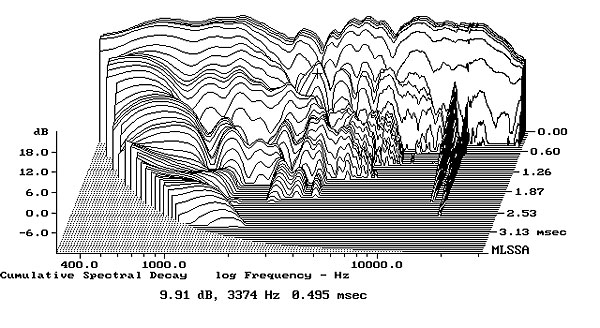
Overall, the Wilson Duette's measured performance suggests that it is a well-engineered design optimized for use close to the wall behind it.—John Atkinson

I like to see products like this, where the manufacturer isn't cutting corners in an attempt to broaden their market. There are a few people who have more money than interior space, and this is a good solution.

These look like an update on the Ruark Equinox from the mid-90's. They are an absolute audiophile bargain if you can find someone to part with their pair.
http://www.stereophile.com/standloudspeakers/297ruark/index.html